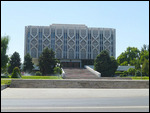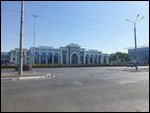Returning to Tashkent after almost 4 weeks of new Central Asian experiences, we were ready for a new beginning. We had obtained a good measure of the geography of the region (the high mountain passes and valleys, rough roads and tunnels under construction), rewarding interactions with the various peoples and their culture and encounters with intrusive public officials. Now, we could begin another phase of exploration that would take us through the Silk Road cities of Uzbekistan.
Our Central Asian itinerary thus far may have seemed like a series of random accidental decisions but there was a method behind all that going back and forth
. The primary factor that influenced it was the weather. It made sense to cover Tajikistan and Kyrgyzstan (with their high mountainous regions) first before the onset of October. Tashkent offered the best air connection from India and so we had to start from there. So, the progression of Tashkent-Tajikistan-Kyrgyzstan-Kazakhstan may seem to be in the wrong direction (why go north when winter is approaching) in a latitudinal sense, it made perfect sense when viewed from the perspective of altitude. With October around the corner, and the mountains behind us, we can now look westward at the Kyzyl Sum desert and visit the famed, almost mythical, cities of the Silk Road in agreeable weather conditions. The desert had a reputation for being hot as late as September, so we hoped for cooler daytime temperatures in October without freezing up at night.
But first, we had one more visa to get in Tashkent. By this time, we had given up our plans for Turkmenistan due to the constraints imposed by their visa requirements
. Once the decision was made, we could focus on planning for Azerbaijan. Despite a lot of research, it took a while for us to find the gate to the embassy, only to be told by the driver of the shiny BMW (which he was washing to maintain its good looks) with diplomatic plates that the Consul was not on the premises. The guard just shrugged his shoulders with a "What can I do?" expression. When the duo saw that we did not turn heel and disappear like they expected us to, they huddled together to look for a better approach to dealing with us. The driver dropped his hose and pulled out his mobile. The guard took our passports and a full quarter hour to enter our details into a register. The driver then indicated to us that the Consul was on his way. There was a convenient set of benches under a shelter just outside the embassy. The Consul arrived with his family in an identical shiny BMW and briefly nodded at us before going in. He did not seem upset at having been woken up at 10:30 in the morning on a Monday just because of a couple of drifters who did not seem to have gainful salaried employment
. We were ushered into his office. We enjoyed the large map of Azerbaijan on the wall and we used it to memorize a few place names which we could use in our proposed itinerary. Our research had indicated that a lack of preparation could lead to puny 3 day visas. We really needed to make up a good story. We noticed that the book "Armenian Terror" was prominently displayed on the table where we were asked to fill out our forms. Our jaws collectively hit the floor on being told the cost of the visa and stayed there when it was doubled for "express" same day service. Standard service would take two weeks. At our urging, he said he could try and give us a 50% discount on the incremental portion of the "express" service but no more. After much good natured haggling, we decided to stick with the original "standard" service. Since we had not opted for "express", the earliest he could give us our visas was the next morning. Unlike the Kazakh embassy official in Bishkek, he was more than willing to endorse copies of our passports for use with the police
. We had run out of copies and we had to ask him if he could kindly put his copier to use for our benefit? He nodded and with a straight face said "That would be another hundred and sixty dollars" and seemed satisfied at our reaction to this touch of humour.
Since we no longer planned to cross into Turkmenistan and had to get back to Tashkent (after our Silk Road trip) for our eventual air connection to Baku, we had two options for our Silk Road itinerary. Do the classic Tashkent-Samarqand-Bukhara-Khiva route in westward steps and return back to Tashkent or jump to Khiva and do it in reverse. Those who did it in reverse said that it made sense to start with Khiva (which was magnificent) and then go on to Bukhara (which was even more magnificent) and then to Samarqand (which was beyond belief). There were other views as well. We opted for the reverse route and lost no time in procuring train tickets from Tashkent to Urgench/Khiva at Tashkent's railway station. We noticed with interest that everyone at the ticket counter carried large bags of Uzbek Som and left with empty bags
. Fortunately, the staff at the counter all had automatic currency counters.
We opted to stay in Tashkent's old town just north of bustling Chorsu Bazaar after our low key hotel experience the month before. We were treated to an enjoyable impromptu recital on the Dutar by the owner of our guesthouse, Mr. Murad Mirzo who happened to be a professor of history. This was an ancestral home going back to his grandfather with traditional fittings and a very nice courtyard. He played several tunes one after the other from memory, ranging from the Babur Nama to Omar Khayyam. He even sang the first two lines of a popular Mukesh song from the 1964 Hindi film Sangam, rendering the emotion faithfully. His English was limited but he managed to convey a great passion for his family and the Uzbek people. Interestingly, he translated this identity to a Turkic one (the byline for his guesthouse was TurkTurizm) and bemoaned the loss of this identity due to the intervention of the Soviet era. The names of Timur and his descendant Babur came up (these two being independent Uzbekistan's iconic heroes) and led to Babur's India connection. He was startled and saddened when we told him that Indian history books held Akbar's name in greater regard than Babur's whose reign lasted a mere 4 years. He spoke of Babur's fondness for his homeland and how he wrote in Babur Nama about his regret in leaving it for foreign lands.
Our host also narrated the story about Timur playing chess and just as he was engaged in swapping his king (Shah) for a rook, he got news of his son's birth and hence named him Shah Rukh. He (our host) became the second person on this trip to express a keen interest in making contact with an Indian movie star. But his intentions were different. He wanted to narrate this same story to Shah Rukh Khan and educate him on the provenance of his name. He pronounced the name like Shakh Rukh, unlike in India where the aspirated syllable in Shah is not rasped from the back of the throat. All over Central Asia, the name is pronounced with the double rasp. The Cyrillic letter for this throat destroying consonant is X. As in Shox Rux Xon. He was also quick to point out that the statue of Lal Bahadur Shastri ("Shastri sculpt" was how he put it) was right next door to his guest house. Our first knowledge of Tashkent was from this association with India's second Prime Minister who had died in 1966 in this city while still in office. We quickly popped around for a look at the smiling statue with the namaste-folded arms when a group of kids in the school nearby saw us and started shouting Namaste at us in excitement.
We got additional exposure to Timur and Babur (Timur's grandson's grandson) during our visit to the Museum of the History of the People of Uzbekistan. Apart from Timur and Babur, the personality of Ulughbek (grandson of Timur) and that of Alisher Navoi featured prominently in our explorations. We had encountered Alisher Navoi (15th Century) for the first time at the Tashkent Metro station that carries his name as well as interior artwork that features his life and works in bluish tiles. The familiar figures of Laila-Majnun, Farhad-Shirin (we had learnt enough Cyrillic to decipher them) were rendered on the walls of the Alisher Navoi station. Ulughbek was not just a ruler but also a famed scientist-astronomer whose name belongs with the likes of Tycho-Brahe and Copernicus. We resolved to enhance our knowledge of these historical figures and what better way to do it than during our visit to the cities where they lived and died? How is it that Timur, whom the outside world regards as a mass murderer, is a great national hero in this country? And Babur's descendence from Timur and Chengiz Khan is considered a double badge of honor here, when in the outside world it would clear the room fast? Of course, Alisher Navoi's native Herat (in present day Afghanistan) was beyond the reach of our current trip, but Timur and Ulughbek's Samarqand was very much in our plans.
A visit to the Tashkent Fine Arts Museum prepared us even further for our forthcoming trip. Paintings and embroidery associated with Samarqand, Bukhara and Khiva featured prominently. The museum did include a small display of foreign artifacts including an Indian section that featured the Veena (South Indian classical string instrument) and silk sarees. A few other countries were included as well.
The guesthouse was also a great place to meet other travelers and exchange notes. There were a couple of bicyclists (Roberto and Annika) who were on the road for several months exploring various cuisines and cultures. Lin (from China) was intent on getting to Afghanistan to view the Bamiyan Buddha remains after a fast transit through the Silk Road. We also met Ruvan, who we had previously seen in Karakol, Kyrgyzstan. A couple from the Nederlands were exploring Uzbekistan for its fabrics. Tamili (from Israel) had just returned from her Silk Road journey and shared her experiences with us which was useful in making our own plans.
Some History Lessons
Tuesday, October 02, 2012
 Tashkent, Toshkent Shahri, Uzbekistan
Tashkent, Toshkent Shahri, Uzbekistan
Other Entries
-
57First Taste of Tajik Hospitality
Sep 0428 days prior Khujand, Tajikistanphoto_camera14videocam 0comment 0
Khujand, Tajikistanphoto_camera14videocam 0comment 0 -
58Over Shakhristan Pass
Sep 0527 days prior Panjakent, Tajikistanphoto_camera11videocam 0comment 2
Panjakent, Tajikistanphoto_camera11videocam 0comment 2 -
59Eleven in a Jeep
Sep 0626 days prior Panjakent, Tajikistanphoto_camera8videocam 0comment 2
Panjakent, Tajikistanphoto_camera8videocam 0comment 2 -
60Fan Mountains and Marguzor Lakes
Sep 0725 days prior Marguzor, Tajikistanphoto_camera16videocam 0comment 2
Marguzor, Tajikistanphoto_camera16videocam 0comment 2 -
61From Remote Mountain Village to Capital City
Sep 0824 days prior Dushanbe, Tajikistanphoto_camera9videocam 0comment 2
Dushanbe, Tajikistanphoto_camera9videocam 0comment 2 -
62Independence Day at the Capital
Sep 0923 days prior Dushanbe, Tajikistanphoto_camera10videocam 0comment 2
Dushanbe, Tajikistanphoto_camera10videocam 0comment 2 -
63Crossing a Remote Border into Kyrgyzstan
Sep 1121 days prior Jirgatol, Tajikistanphoto_camera18videocam 0comment 2
Jirgatol, Tajikistanphoto_camera18videocam 0comment 2 -
64Onward from the Kyrgyz border
Sep 1220 days prior Osh, Kyrgyzstanphoto_camera22videocam 0comment 2
Osh, Kyrgyzstanphoto_camera22videocam 0comment 2 -
65Kyrgyzstan's Second Largest City
Sep 1319 days prior Osh, Kyrgyzstanphoto_camera9videocam 0comment 2
Osh, Kyrgyzstanphoto_camera9videocam 0comment 2 -
66How could you not go to a place called Arslanbob ?
Sep 1517 days prior Arslanbob, Kyrgyzstanphoto_camera15videocam 0comment 1
Arslanbob, Kyrgyzstanphoto_camera15videocam 0comment 1 -
67The Long Road to Bishkek
Sep 1814 days prior Bishkek, Kyrgyzstanphoto_camera14videocam 0comment 3
Bishkek, Kyrgyzstanphoto_camera14videocam 0comment 3 -
68Seven Bulls and a Broken Heart
Sep 2012 days prior Karakol, Kyrgyzstanphoto_camera13videocam 0comment 2
Karakol, Kyrgyzstanphoto_camera13videocam 0comment 2 -
69At Song Kul Lake - An Unforgettable Experience
Sep 2210 days prior Kochkor, Kyrgyzstanphoto_camera23videocam 0comment 0
Kochkor, Kyrgyzstanphoto_camera23videocam 0comment 0 -
70Back to Bishkek
Sep 239 days prior Bishkek, Kyrgyzstanphoto_camera0videocam 0comment 5
Bishkek, Kyrgyzstanphoto_camera0videocam 0comment 5 -
71Almaty
Sep 266 days prior Almaty, Kazakhstanphoto_camera16videocam 0comment 1
Almaty, Kazakhstanphoto_camera16videocam 0comment 1 -
72Day Trip To Turkistan
Sep 284 days prior Shymkent, Kazakhstanphoto_camera8videocam 0comment 1
Shymkent, Kazakhstanphoto_camera8videocam 0comment 1 -
73The Border Crossing You Dont Want To Repeat
Sep 293 days prior Tashkent, Uzbekistanphoto_camera5videocam 0comment 4
Tashkent, Uzbekistanphoto_camera5videocam 0comment 4 -
74Some History Lessons
Oct 02 Tashkent, Uzbekistanphoto_camera5videocam 0comment 2
Tashkent, Uzbekistanphoto_camera5videocam 0comment 2 -
75From Slave Market to Museum
Oct 042 days later Khiva, Uzbekistanphoto_camera14videocam 0comment 1
Khiva, Uzbekistanphoto_camera14videocam 0comment 1 -
76How Much Renovation is Just Right?
Oct 064 days later Bukhara, Uzbekistanphoto_camera32videocam 0comment 3
Bukhara, Uzbekistanphoto_camera32videocam 0comment 3 -
77Timur Land
Oct 097 days later Samarkand, Uzbekistanphoto_camera28videocam 0comment 1
Samarkand, Uzbekistanphoto_camera28videocam 0comment 1 -
78Goodbye To The 'Stans
Oct 108 days later Tashkent, Uzbekistanphoto_camera6videocam 0comment 2
Tashkent, Uzbekistanphoto_camera6videocam 0comment 2 -
79Still In Asia Or Is This Europe?
Oct 1311 days later Baku, Azerbaijanphoto_camera28videocam 0comment 1
Baku, Azerbaijanphoto_camera28videocam 0comment 1 -
80Foothills Of The Caucasus Mountains
Oct 1412 days later Lahic, Azerbaijanphoto_camera16videocam 0comment 2
Lahic, Azerbaijanphoto_camera16videocam 0comment 2 -
81Vikings Originally Came From Azerbaijan?
Oct 1614 days later Sheki, Azerbaijanphoto_camera13videocam 0comment 1
Sheki, Azerbaijanphoto_camera13videocam 0comment 1 -
82An Azerbaijani Family
Oct 1614 days later Sheki, Azerbaijanphoto_camera0videocam 0comment 3
Sheki, Azerbaijanphoto_camera0videocam 0comment 3 -
83A Change of Faith
Oct 1917 days later Tbilisi, Georgiaphoto_camera16videocam 0comment 3
Tbilisi, Georgiaphoto_camera16videocam 0comment 3 -
84Dzhugashvili and Svetitskhoveli
Oct 2018 days later Gori, Georgiaphoto_camera17videocam 0comment 2
Gori, Georgiaphoto_camera17videocam 0comment 2 -
85A Border Runs Through It
Oct 2119 days later Davit Gareja, Georgiaphoto_camera15videocam 0comment 2
Davit Gareja, Georgiaphoto_camera15videocam 0comment 2 -
86In the Greater Caucasus Mountains
Oct 2321 days later Qazbegi, Georgiaphoto_camera15videocam 0comment 1
Qazbegi, Georgiaphoto_camera15videocam 0comment 1 -
87The Pink Capital of Armenia
Oct 2624 days later Yerevan, Armeniaphoto_camera22videocam 0comment 2
Yerevan, Armeniaphoto_camera22videocam 0comment 2 -
88Colors Of The North - Dilijan and Lake Sevan
Oct 2725 days later Dilijan, Armeniaphoto_camera14videocam 0comment 2
Dilijan, Armeniaphoto_camera14videocam 0comment 2 -
89The Armenian Apostolic Church
Oct 2826 days later Echmiadzin, Armeniaphoto_camera13videocam 0comment 0
Echmiadzin, Armeniaphoto_camera13videocam 0comment 0 -
90Two Monasteries And A Winery
Oct 2927 days later Areni, Armeniaphoto_camera9videocam 0comment 0
Areni, Armeniaphoto_camera9videocam 0comment 0 -
91Tatev (Give Me Wings)
Oct 3028 days later Goris, Armeniaphoto_camera10videocam 0comment 0
Goris, Armeniaphoto_camera10videocam 0comment 0 -
92The Nagarno Karabakh Republic
Oct 3129 days later Stepanakert, Azerbaijanphoto_camera18videocam 0comment 2
Stepanakert, Azerbaijanphoto_camera18videocam 0comment 2
Comments
2025-05-22
Comment code: Ask author if the code is blank

 Tashkent, Toshkent Shahri, Uzbekistan
Tashkent, Toshkent Shahri, Uzbekistan











Ramesh
2012-10-20
The history lesson simply whets the appetite for what lays ahead. But all this seems to be from the Timur era. Isn't there fodness for the period before Genghis sacked all these cities. The days of the Khwarazm Shah and before when Samarqand and Bukhara were probably the greatest cities in the world ???
parleusted
2012-10-21
With nothing tangible left from the time of the Khorezm Empire, there is hardly a reference to it in either Samarqand or Bukahra. Museums in Khiva (which later became the Khorezm capital) cover some of that history, but the details in English were sketchy. Actually important Khorezm cities like Konye-Urgench and Merv are inside current day Turkmenistan, so unfortunately we were unable to visit.